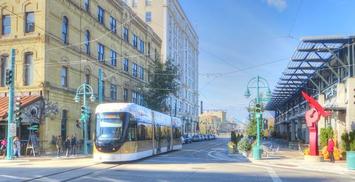
Due to circumstances entirely within the city of Milwaukee’s control, it can’t afford to fix potholes in city streets and it certainly won’t pay to repair the damage to at least 45 cars caused by those potholes so far this year. The circumstances are that, instead of fixing streets, the city decided to blow $123 million on a 2.1-mile streetcar line.
Nor will it have money for fixing potholes in the future. That’s because the Democratic National Convention is going to be held in Milwaukee next summer, and the city plans to blow another $28 million building a 0.4-mile extension of the streetcar line beyond the convention center — a convention center, by the way, whose expansion is costing the city $247 million to $277 million.
Defenders of the streetcar protest that it is being paid for out of tax-increment financing (TIF), which Politifact seems to think is free money. In fact, since any new development in a TIF district would have happened without the TIF — all the TIF does is influence the location — TIF does not produce new tax dollars; it just diverts dollars that should have gone to schools, streets, and other city services to subsidize the development.
Politifact also says a claim that the streetcar is a “1900s-style trolley” is only half true because the streetcars will be “modern.” So they are saying they could put a Lamborghini body on a Model-T Ford and call it “modern.”
In fact, the Antiplanner would rate calling the streetcar a “1900s-style trolley” a half-truth as well; it’s really an 1880s-style trolley with a 1930s-style streamlined body. Like the 1880s streetcars, its average speed is only about 7.4 miles per hour, as it takes 17 minutes to travel 2.1 miles. That’s hardly “modern.”
The city considers the streetcar a great success because it has carried 2,100 riders a day since it opened last November. With 144 trips per day, that’s fewer than 15 riders per trip. Some transit agencies would seriously consider dropping a bus line that carried that few riders.
In any case, Milwaukee once again proves that politicians put ribbons over brooms; that is, they would rather spend money on new projects than maintain existing infrastructure. It will be a sad day if Congress ever does pass a $2 trillion infrastructure bill, as it will probably fund a lot of new infrastructure that we don’t need and won’t be able to afford to maintain while our existing infrastructure will continue to deteriorate.
This piece originally appeared on The Antiplanner.
Randal O’Toole is the director of the Independence Institute’s Transportation Policy Center and author of the recent book, Romance of the Rails: Why the Passenger Trains We Love Are Not the Transportation We Need.
Photo: The Milwaukee streetcar trundles through the city at an average speed of 7.4 miles per hour. Flickr photo by David Wilson.












